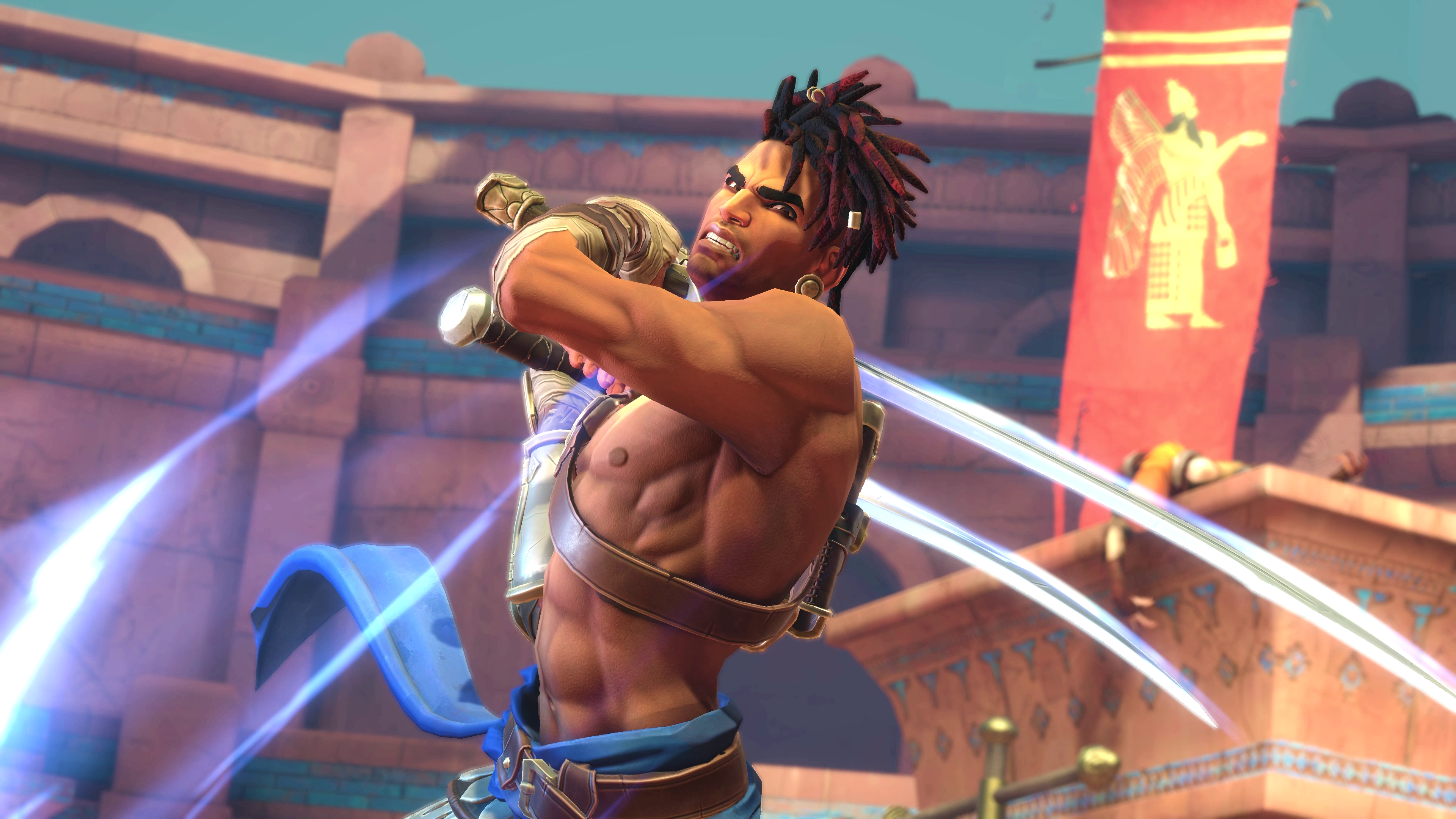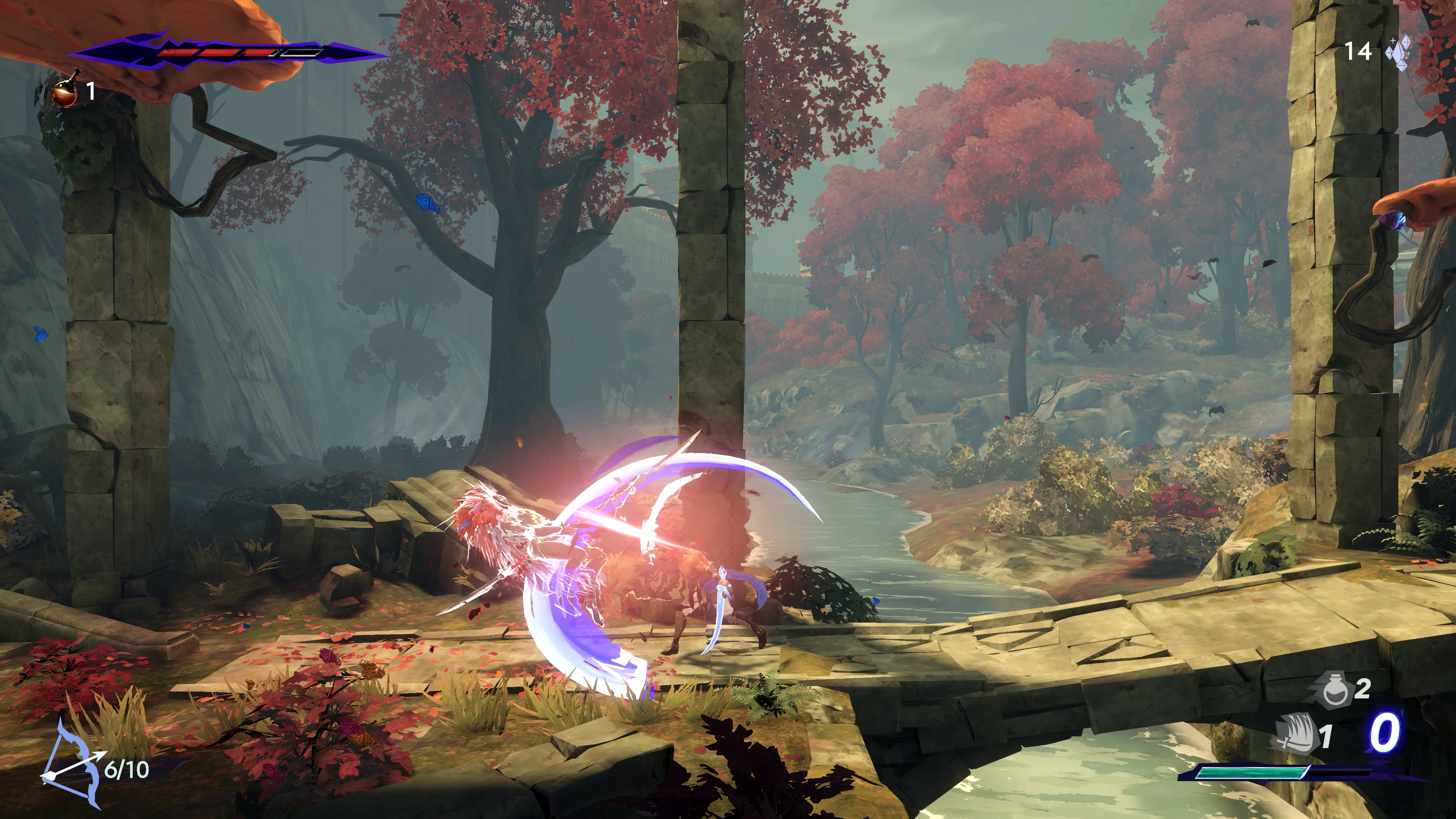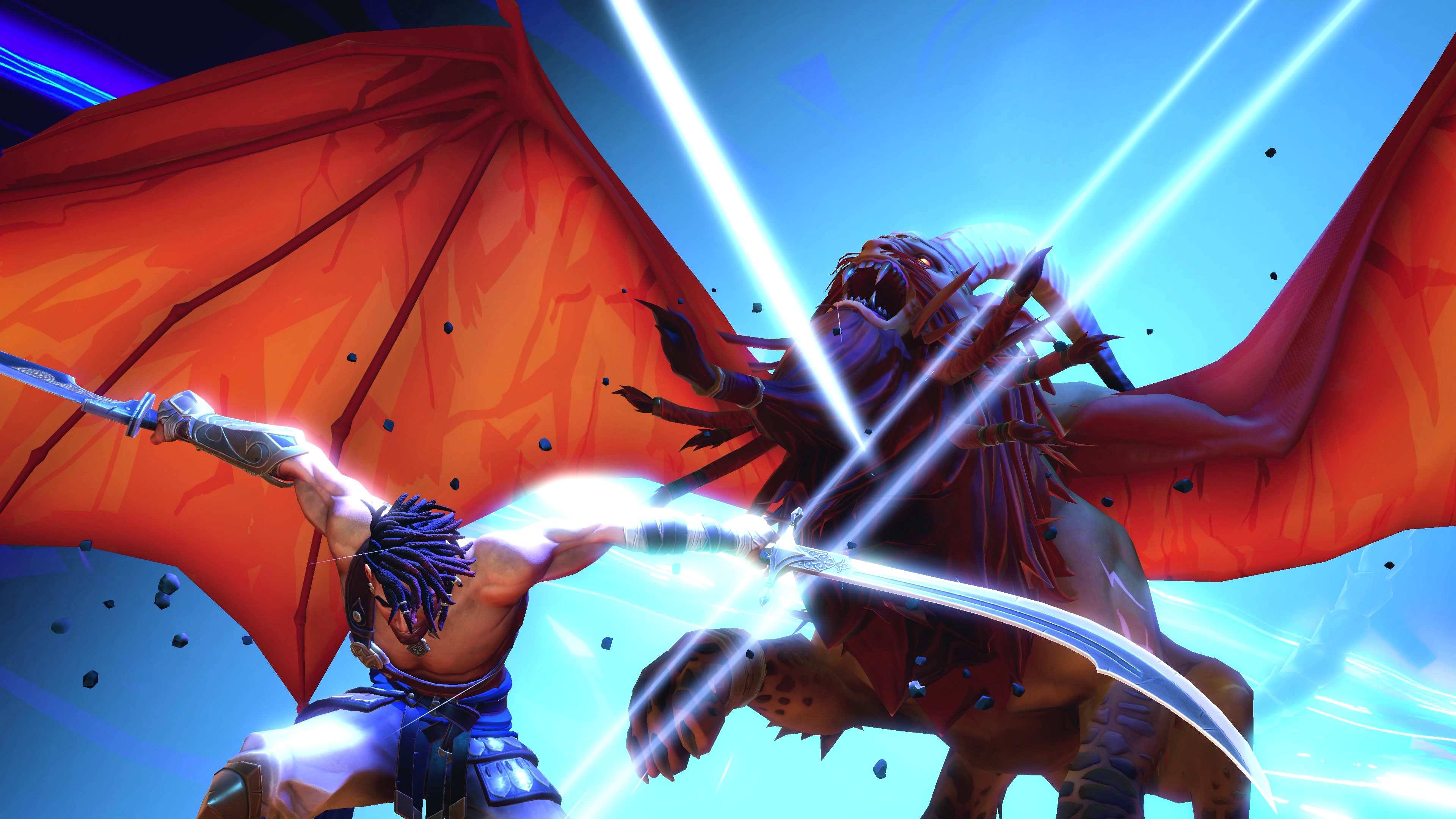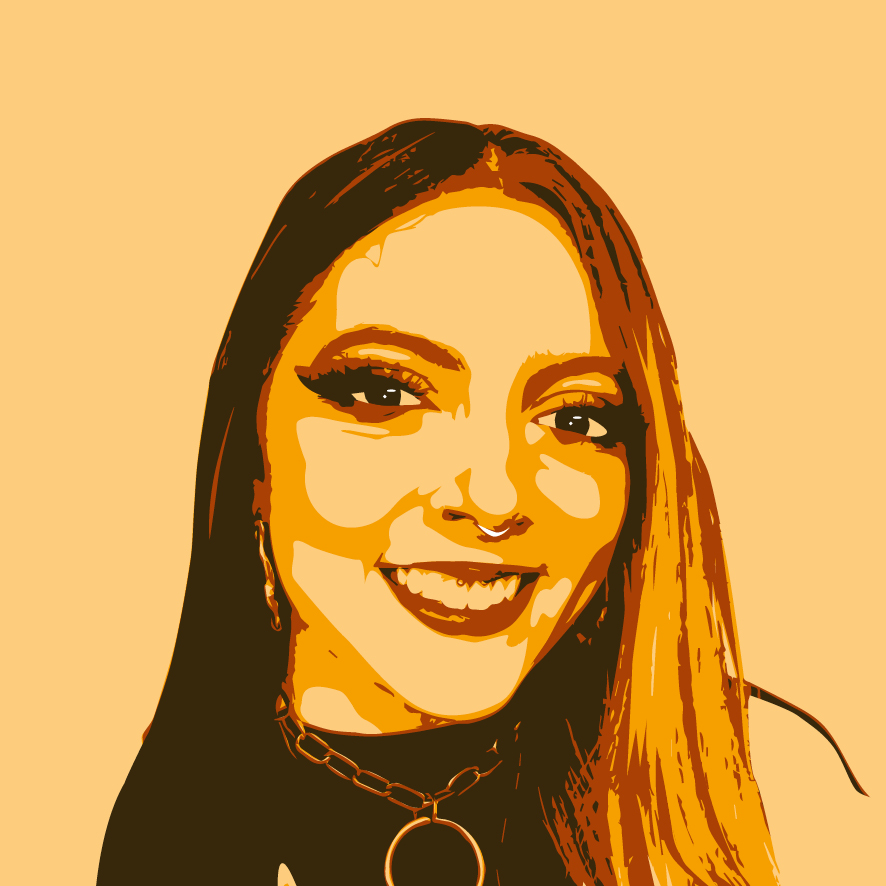Prince of Persia: The Lost Crown may not be the game you were hoping for, but trust me, it's the one you need
Ubisoft is going back to Prince of Persia's roots with a modern twist.

"Prince of Persia meets Dragon Ball Z" wasn't the elevator pitch I expected when I visited Ubisoft's Montpellier studio last month, but that's exactly what I got. The team frequently cite anime—and their love for it—as the inspiration behind the exuberant visual style for the upcoming Prince of Persia: The Lost Crown.
You wouldn't think it would work, but it really does. The Lost Crown is still filled with gorgeous Persian architecture, mind you. Sprawling sandy columns and intricate statues adorn the small section I was given a hands-on with. But when I parry an enemy or unleash a super move, the landscapes are splattered by explosions of colour and animations that look like they're straight out of Street Fighter or Dragon Ball FighterZ. Yep, Prince of Persia is back, and this time it's brimming with style.
I know it's not exactly the Prince of Persia fans have come to expect, especially with the hotly-anticipated Sands of Time remake currently drifting on the desert winds. I'd consider it no bad thing that it's going for such a different feel, though. With the team behind the excellent Rayman Legends working on The Lost Crown for the last four years, the result is a gorgeous 2.5D sidescroller that hearkens back to Prince of Persia's origins while imagining a new future for the series and features all sorts of utterly devious puzzle platforming with some mighty satisfying execution.
Embrace tradition
Preserving the 33-year legacy of the series while giving it a fresh, modern coat of paint has been a core goal of The Lost Crown's development. This means waving bye-bye to the unnamed Prince and saying hello to a new hero named Sargon. It does feel strange bidding farewell to the series' most recognisable face, but this upstart seems like a rather likeable young fella. He's swift and elegant, but hot-headed and vicious, too.
The team describes Sargon as being like a tiger, which emanates in the way he moves and fights. I'm able to sprint and airdash across large distances, slashing down upon enemies with my sword or taking a shot at them from a distance with my arrows. When I wanted to play more tactically, I could wait for the perfect moment to parry their moves and deal tons of damage. Sargon is also blessed with the classic time powers, being able to slow things down or use teleportation to anchor a past version of himself to zip back to at any moment.
I can mix and match these movement and combat abilities to take on enemies in all sorts of ways. Some require me to dash behind them and perform a melee combo at their backs, and I was able to leap into the air and swing my weapons down on two enemies on either side of me in a beautiful double-whammy attack. I could use my teleport to give myself a bit of breathing room in tense moments, too. Performing all these different attacks fills up my special meter, allowing me to perform grand fighting style-like super moves. Some of them let me heal up, while others deal huge chunks of damage to enemies in the firing line.
If you're just walking up to enemies and melee comboing all of them, the combat can feel a little samey. Half of the fun is making full use of the toolkit, and simply slicing them to death won't work forever. There are also amulets that can be found around the world that provide buffs or extra treats for abilities, like invincibility frames on dodges.
Keep up to date with the most important stories and the best deals, as picked by the PC Gamer team.

The animations and colour palette play a huge part in what makes The Lost Crown so fun to play. Parries and super moves have a bright, kinetic energy which is part of Ubisoft's effort to modernise the look and feel of Prince of Persia. I bring up the huge 2D fighter and anime vibes to game director Mounir Radi, and he tells me that's exactly what the team have been aiming for. A huge Street Fighter fan, he looked at key mechanics like reversals and how frame data works to shape The Lost Crown's combat, flow, and sweat-inducing strategic plays. "You can take a risk by staying in the heat of combat, trying to avoid some attacks and launching your super just before losing the last HP that you have," says Radi. "That was kind of, you know, something that I wanted the players to feel."
Radi cites classic anime like Hunter x Hunter, Beserk, Demon Slayer, and Dragon Ball Z as influences on The Lost Crown's ultra-stylised look. The team has been rather clever with how much it's taken from Japanese animation—it's not a full-blown anime Prince of Persia game with all the trimmings of shounen dialogue and character design. Rather, the inspiration comes through in the visual effects of Sargon's time powers, the way he appears to wall run when airdashing, and the Kamehameha-adjacent animation I witnessed after defeating my first big boss during my hands-on.

There are glimpses of other pop culture too, with art director Jean-Christophe Alessandri citing a whole host of inspirations. "We love anime, we love superhero comics, all this energy you can find in this kind of art," he says. He goes on to explain that the whole team brought their own love for modern culture to the table, with things like street art and contemporary fashion coming into play as well. The Lost Crown feels a lot like a peanut butter and jelly sandwich: The ingredients seem at odds with each other on paper, but with the right ratio they manage to work together in perfect harmony.
It's a significant shift for the series, but one that feels sorely needed. Prince of Persia has struggled to find its feet in the last decade, but it feels like the series is right at home in the hands of the folks at Ubisoft Montpellier. Everything I'm shown—from my actual time with the game to every little detail stuffed into its Persian mythology enemies and level design, backed with a soundtrack from the fantastic Gareth Coker (the composer behind Ori and the Blind Forest) with trickles of colourfully dramatic animations—blends together beautifully. It's great that the game has such charming looks, but crucially it feels fantastic to play, too.
Puzzling platformer
Movement is tight and responsive, which is vital for some of The Lost Crown's intense puzzle platforming sequences. It also makes the trial and error of completing them far less frustrating—my deaths always feel like a skill issue on my part, rather than the game doing me dirty. The checkpointing for the segments I played was right in the sweet spot too—far back enough to give enough challenge, but not so mean that I'm repeating long segments. There are some dastardly levels for sure, with pillars that fall from the sky out of nowhere and spikes that are tucked just out of the frame as Sargon drops down a narrow vertical gap. Tools like wall jumping and airdashing require precise timing, and some levels even include sections where I have to aim an arrow to shoot a platform trigger or even make use of his teleport ability to zip myself back up towards a rapidly-vanishing floor.
There are tons of opportunities to stray off the path and explore secret areas, too. Even in the relatively brief time I had with the game, I got to poke around a lot of nooks and crannies, finding secret entrances and hidden areas tucked away in dark corners. Exploration is another core pillar of The Lost Crown's development, and for how fun and responsive moving around in this game is, it didn't feel like a chore to go hunting across the map to discover new locations. There are minimal guidance cues too, which left me free to play as I wanted without unnecessary hand-holding. Radi tells me that The Lost Crown will have a variety of settings and difficulties that can be tweaked, so those who want a more linear, story-driven experience with extra guidance can have that.

Radi calls the game "a new chapter," and I notice the team try their best not to mention Sands of Time too much, but it's hard to hide from the series' most successful entry. "There are some links with the legacy. And I think some could see our game like a prequel, maybe, even if it's not." I ask if it's almost like a spiritual prequel, and Radi agrees. He says there are even some easter eggs too, like a few classic sound effects and some ties to the lore from the 3D trilogy, saying "they are scattered everywhere in the game." Alessandri also admits to me that there are a few easter eggs to be discovered, but won't tell me what neat things can be found for fans, saying "I'll let you discover that."
I have to agree with Radi when he calls it a new chapter—not just for the Prince of Persia story, but for the series. I know general reception to The Lost Crown's announcement hasn't been too hot so far, but I think people have been far too quick to jump to conclusions. It's certainly not Prince of Persia as we've come to know it, but considering how the last 10-15 years have gone for the series, is that necessarily a bad thing? Though I only had a few hours with it, I'm absolutely digging what The Lost Crown has going on right now. Trust me, once it's in your hands, it's going to blow you away.

Mollie spent her early childhood deeply invested in games like Killer Instinct, Toontown and Audition Online, which continue to form the pillars of her personality today. She joined PC Gamer in 2020 as a news writer and now lends her expertise to write a wealth of features, guides and reviews with a dash of chaos. She can often be found causing mischief in Final Fantasy 14, using those experiences to write neat things about her favourite MMO. When she's not staring at her bunny girl she can be found sweating out rhythm games, pretending to be good at fighting games or spending far too much money at her local arcade.

